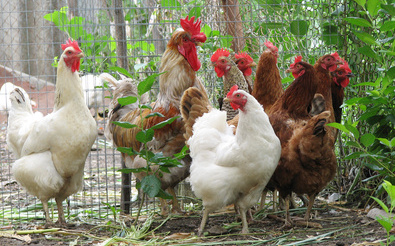Chicken coop enclosures
Of course, there are many factors to
consider in building a chicken coop, but one thing many people neglect to think about is
how much space to give chickens in their yard.
Some backyard chicken owners allow their chickens to roam their whole yards, which is good for
the soil and helps control insects and weeds. But chickens will also eat the plants in your
garden, and many people prefer to build a chicken run or enclosure outside the coop,
which can protect both chickens and plants

Free Range Or Contained?
One of the primary
concerns in building a chicken enclosure is space. The chickens need enough
space to exercise and feed. Your enclosure should be no less than ten square feet and depending on
the number of chickens you raise, you should allow plenty of space to
roam. It is also a good idea to cover the top of your enclosure, which will protect
your chickens from some predators, such as hawks.
Tips For Enclosures
Like your coop, your enclosure should be in
a well drained area. You want the water to run off from the enclosure, which
will help avoid puddles. This will keep your chickens healthy and allow them to
use the entire run. In addition, like the coop, the run should receive as much light as
possible. Chickens lay eggs much more often when their environment is
well-lit.
It is also important to think about
where your run is placed in relation to your coop. Some people choose to
build their coops inside their chicken runs, which helps ensure that the chickens
stay inside them but also requires more wire netting to build the enclosure.
Others build a chicken run that is entirely separate from their coop, though it can occasionally
be difficult to lead the chickens into the enclosure in these cases.
The most common form of enclosure is connected to the chicken coop, so that the
chickens can walk out their chicken door directly into the run whenever they choose.
In order to make your chicken run last for the long term, many
people suggest splitting it in two parts, so that while chickens scratch in one area
for awhile, the other will have time to recuperate.
To learn more about all of these options as well as get construction plans and materials lists for
a variety of different enclosure designs, I recommend that you get Bill Keene's book with plans and several bonus
offers. To check that out and take advantage of our limited time special bonus offer just click here.
This helps ensure that there are insects and worms as well as grass or other plants for your
chickens to eat at all times. By switching the chickens’ enclosure regularly
between the two, you will have a happier garden and happier chickens, as well as
healthier eggs.
Valuable Help For Your Chicken Coop
Project
For a limited time, we are offering a free bonus 49 page eBook called Beginners Guide to Raising Chickens when you get Bill Keenes "Building a Chicken Coop." You
can spend a lot of time researching on your own - or take a shortcut and learn all about raising chickens with this
outstanding special package just Click Here to get started.
| 
